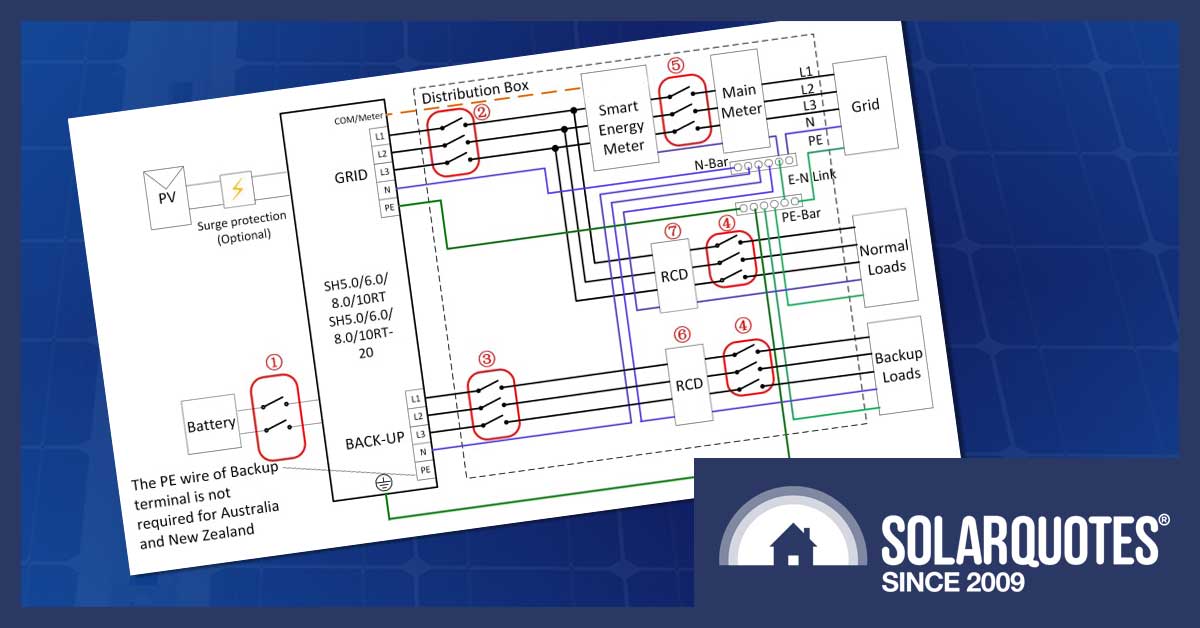
3 phase wiring diagram for full home backup from Sungrow
So you have a 3-phase supply to your place, and you’d like solar with battery backup?
Pickings were slim in 2018 when we last reviewed the situation. The good news is, since then, many new hybrid inverter models have entered the market, and full 3-phase backup is now possible without dropping crazy amounts of cash.
It might be worth brushing up on the terminology and some of the basic principles of energy storage if you’re unfamiliar with the jargon, but for this article, I’ll dive into 3-phase battery backup more specifically. It’s a long read because more phases means more complexity.
You Probably Only Need Single-Phase Backup
Three-phase loads are generally large appliances like;
- Ducted air conditioning
- Bore pumps
- Workshop machinery
- Large solar inverters
- and EV charging, too
You need a large and expensive home battery to meet these challenging loads without the grid.
Everything else in your house is single-phase, and in many cases, even large air conditioners can be single-phase units. Many EVs (including all BYDs) only have single-phase charging too.
So, if you just want the fridge, lights and WiFi to work in an outage, then you only need a single phase backed up. In fact, single-phase hybrids invariably have better surge capacity when running in off-grid mode, so if you have a rainwater pump to fill the kettle and flush the loo, then a 3 phase hybrid inverter might not be as capable.
- The greatest choice in AC-coupled and DC-coupled hybrid inverters is in single-phase models.
- With solar on a 3-phase house, it’s an efficient design to only back up one of the phases, with all your essential loads on that phase1.
Perhaps Wiring Will Decide Your Needs.
Where you may need 3-phase backup from a battery is if you have a specific 3-phase load, like a fire pump, or if the wiring in your premises covers different floors. Segregating backup circuits can be difficult or impossible if 3 phases feed three different buildings, for instance.
If you already have a legacy 3-phase solar inverter, then integrating that will require careful design and equipment selection from your installer. Some hybrid inverters play well with others, but many will not; compatibility can be case by case, so get your expectations documented in the quote.
Armageddon Proofing
If money is no object and you want to treat the grid with contempt then you’ll use three Selectronic SpPros and a raft of other complimentary equipment. A bespoke design, class 6 battery from a specialist installer all means you’ll get no change from $100,000 by the time the shouting has died down. There’s a good chance your existing Fronius or ABB/Fimer solar inverters will be compatible though.
In a similar vein, soon there will be another option available for remote area jobs. A very well-respected Australian firm has developed the Xess One and has some promising specifications.
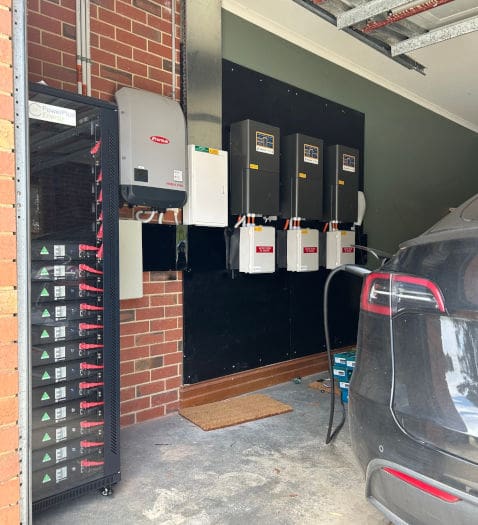
Charging an EV with a 3-phase Selectronic SpPro, PowerPlus batteries & Fronius solar inverter. This homeowner will power through Armageddon, no problem (unless it’s a nuclear winter). Full credit to Chris Stork and PowerPlus batteries for this installation.
Powerwall Is Popular But Not Plausible
People love the Tesla Powerwall. Customers and installers alike know they work really well. However, 3 phase is Tesla’s Achilles heel. In the US, there simply isn’t any demand for 3 phases (until you get into heavy industry), so Tesla doesn’t design for it. 110 V AC house wiring, fluid ounces, acres, feet and now NACS connectors for home EV charging,… the freedumb eagles are just weird.
It’s not that you can’t have a Powerwall on a 3-phase supply; many do, and they enjoy lower bills. However when the grid fails, you have single-phase backup only.
Tesla simply doesn’t form a 3-phase 120° synchronised grid.
You can have three Powerwalls backing up three separate single-phase supplies during an outage, but they will not work together to run a synchronous 3-phase load, and they cannot charge from a 3-phase solar inverter (you’ll need 3 x single-phase solar inverters or microinverters).
Proper 3 Phase backup With Fronius Gen24
Available in a range of sizes up to 10kW, Fronius offer class leading surge capacity of 3.7kW per phase and modular battery capacity from stacks of BYD batteries. We have outlined many details previously, but it’s worth noting these machines work in parallel with your grid supply. They have a backup box arrangement to disconnect the mains supply, so there are some inherent features.
- As a DC-coupled hybrid they can black start if the battery runs flat overnight
- All the circuits in your house will be backed up (unless they’re segregated in the switchboard)
- If the inverter fails, the house carries on as normal. No emergency changeover switch is needed.
- There is a 30-ish second delay in changeover when the grid fails. I call it a feature because it’s an unmissable analogue signal, a warning that you need to back off consumption and conserve energy
- During an outage, the Fronius unit will form a supply at 53Hz. This is a deliberate action to make sure that no other inverter will stay online. Fronius will not tolerate other solar supplies.
- Some appliances may not tolerate the Fronius 53Hz output 2
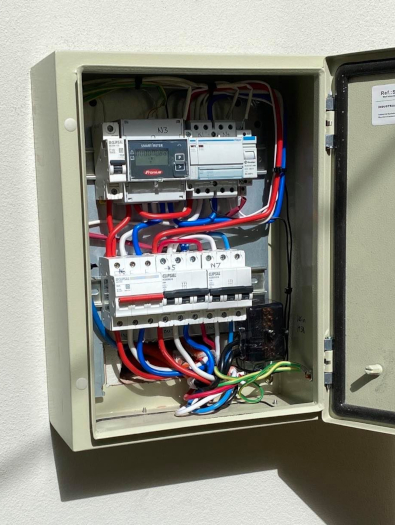
3 Phase Gen24 will need a “backup box” like this inside or near the switchboard. image credit Jae Taylor
Pfft; SolarEdge Is A Bust, Enphase Are Non-starters
Available internationally and offered here for a short time, the 3-phase SolarEdge solution was a false start. They do offer single-phase parallel hybrids, but until we get the Australian Standard for inverters, AS4777 rewritten, Solar Edge 3 phase isn’t an option.
The Enphase 5p battery and system controller only offer single-phase backup.
Great Value 3-Phase Backup: Sungrow SH5-10RT
From up-and-coming to a solid contender, Sungrow has some persuasive technical reasons for 3-phase customers. They currently offer a range up to 10kW, but we understand a 15kW unit is coming soon. Sungrow has a really well-resolved stackable battery in 3.2kW increments. As a DC-coupled hybrid, they can black start if the battery runs flat overnight.
They can also run more solar capacity on the backup side. An extra solar inverter will help run appliances, help recharge the battery and help meet surge loads (if there’s sunshine, of course). If this is a Sungrow unit it’ll marry up in the monitoring platform, but other brands and models can be used successfully, with the Sungrow Hybrid shifting frequency to control generic inverters.
Sungrow is a series hybrid, so all the backup loads are connected through the inverter. This means when the grid fails you probably won’t notice the changeover. It’s not a true uninterruptible supply; they sometimes drop out, but generally, everything stays on.
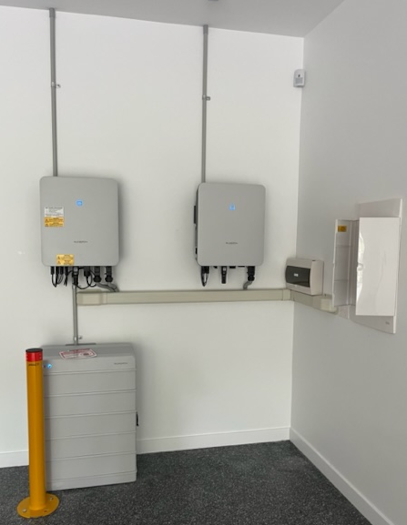
Sungrow makes some solid gear.
There are some disadvantages to the series hybrid architecture Sungrow have chosen:
- Firstly, the backup circuit will only pass through what it’s rated for.
Whether the grid is available or not, the inverter becomes the limiting factor for anything downstream. - More importantly, if something goes wrong, the inverter fails for any reason, and you really need a changeover switch to restore grid supply to your essential circuits. For three phases, that means you need a lot of room in the switchboard.
- Frequency shifting can cause other interference, with random appliances being upset.
Perfectly GoodWe For More Grunt
There is already a 15 to 29.9kW 3ph hybrid on offer from GoodWe. As a series hybrid, they share the same fundamental advantages & liabilities of the Sungrow solution and models. Important to note, though, is that while GoodWe offer a modular battery stack, they do not offer a warranty on expanding your battery at a later date.
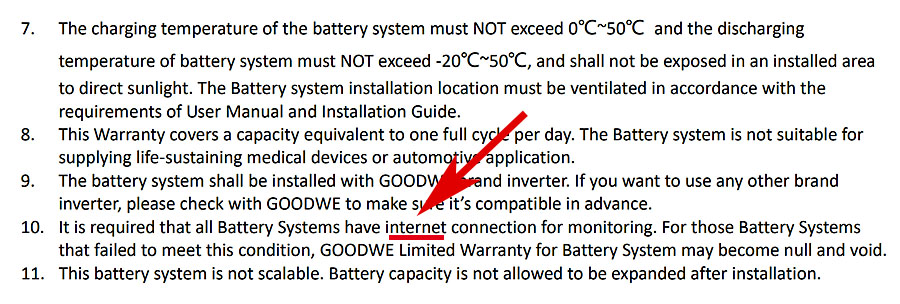
It’s worth reading the fine print for any battery
Pragmatic Redback
Scratch the paint off a Redback unit, and you’ll find more GoodWe hardware, which isn’t a bad thing. The principal difference is the monitoring software, integration and support come from Brisbane. Not only does this mean you have a 10-year warranty, curiously with no other caveats applied, but you also have native integration for flexible export connections, which are increasingly becoming the norm for Australian networks.
Power From Deye or NoArk
Deye inverters are new to market in Australia, and while Deye (pronounced DAY, I’m told) is a large international outfit, choosing a unit with a NoArk sticker on it means you get support from an office in Australia.
These inverters are a crossover between a grid hybrid (high voltage, package engineered, class 4 or 5 BESS) and an “off-grid” inverter with a generator input connection. Some models even support 48-volt nominal batteries, which for a 3-phase all-in-one box is something nobody else offers.
Punting On Cheaper Options
If you’re on a budget and enjoy a punt, Solax, is still available, with gear that has never impressed me, but still being there to honour a warranty is actually a credit to them. Growatt, SAJ, Solis, all appear to have 3 phase hybrid products, but working out if they’re approved might be another matter. Searching the CEC list is made difficult when Solis & SAJ simply don’t appear as brands, so try Ginlong and Guangzhou Sanjing for better results.
Putting In For A Quote?
- You may need an electrician to work out exactly what part of your house uses which phase
- 2 phase properties need two single-phase inverters but might share a 3-phase consumption meter
- DC-coupled hybrids allow you to add more solar than is usually permitted, but they can be set up to work like an AC-coupled battery with existing solar
- Network connections can become complex if you already have solar and are subject to limits of 10kW of inverter per phase.
- Flexible or Dynamic connections may limit your choices in South Australia, Queensland & soon Victoria – not all inverters are compliant
- If you don’t have a specific 3 phase load, then one, two or three single-phase battery inverters may be a solution
- Single-phase inverters offer more surge capacity for things like pumps and fridge motors.
Footnotes
- Just be aware that – if you have opted for single phase backup AND want your solar panels to work in a blackout, you should use 3 x single-phase solar inverters or microinverters. A single phase battery will not charge from a 3-phase solar inverter when the grid has failed ↩
- I’ve heard of frequency shift causing random minor malfunctions, a certain model induction stove, a TV remote, a coffee machine pump ↩

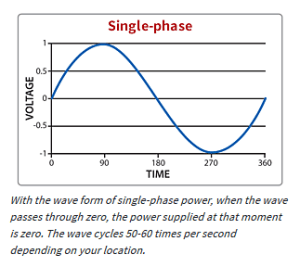
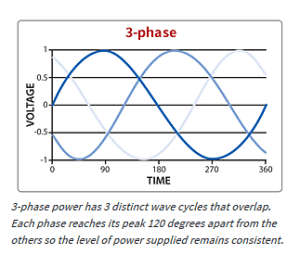
 RSS - Posts
RSS - Posts



Hi Anthony,
Thanks for the article. I have a 3-phase supply, but currently do not have any 3-phase loads (it use to run an old ducted system). What I am looking at though is adding to my existing solar capacity and installing a battery. Currently we have 4Kw of solar on Enphase 215w inverters (total 3.44Kw). I am in the Citipower area and understand it is a 5kw export limit and 10kw inverter limit per phase (battery counts towards inverter limit).
So if I want to add an extra 3-4kw of solar plus a Tesla Powerwall 2 should I put the solar on a separate phase and could this still feed into the Powerwall if it is on the original phase with the existing 4Kw of solar?
Hope this all makes sense.
Replace the system with a Fronius Gen24 Symo Plus, all features required into one 🙂
Supports balanced three phase, integrated battery support and full backup.
I’ve put in a BYD HMV 22Kw battery as well.
They’re a good piece of kit aren’t they Pat.
Thanks for the article, Anthony. An interesting read.
“There is a 30-ish second delay in changeover when the grid fails. I call it a feature because it’s an unmissable analogue signal, a warning that you need to back off consumption and conserve energy”.
I’ve got the Gen24 and big BYD at home.
It would seem to me that a simple display screen connected via cat6 cable would be a much better signal. A simple beep would do the trick.
A simple hard-wired screen in a common area like a kitchen would also make it much easier for everyone in the house to understand the state of the system. Simple and hard-wired would pool poo all over the apps in general day to day use. Especially during an outage when your internet has dropped out and might not boot up perfectly.
The 30 second change over means I’m still running a few UPS units around the house. It’s a drop in the ocean compared to the cost of the whole system. It’s worth noting that this will cost you another several hundred on top of the rest IME.
Auto correct strikes again. Not sure why “pool poo” is better than “poo poo”.
No Picnic bars in the pool please.
Hi
Good write up.
Only issue I had was with one footnote that was:
“Just be aware that – if you want your solar panels to work in a blackout, you should use 3 x single-phase solar inverters or microinverters, not a 3-phase solar inverter”
The Fronius Gen24 Plus Symo does..
I waited several years to get an inverter that does 3-phase, battery backup and runs fully during a grid outage. These conditions are met by the Fronius Gen24 Plus Symo.
3-phase to maximize export to the grid
Battery backup electricity bill reduction
Full or single point backup
Panels provide power during outage
Or have I misunderstood?
Thanks Pat
Fronius Gen24 Plus Symo 10Kw
Trina Honey TSM-DE08M.08(II) 28x 385w 10.7 Kw
BYD HVM 22.1 KwH
Fronius Smart Meter 63A-3
I have the exact same system, 3-phase, Gen24 Plus Symo Hybrid, BYD batteries.
The panels work and charge the battery during a blackout / while disconnected from grid.
That footnote (1) as currently worded is not correct.
Hi Johnno,
You can’t get good editors these days so I’ve reworded for clarity.
Thanks for the heads up.
You are welcome.
I still don’t think it is quite right. Maybe: ‘…if you want your solar panels to work in a blackout, you should use 3 x single-phase solar inverters, microinverters or a three-phase hybrid inverter.’
Hi Johnno/Pat,
did you get a pre made backup box for your Fronius Symo Gen24 plus or did your sparky put it together themselves? Eg https://solarshop.baywa-re.com.au/BayWa-re-Solar-Systems-Symo-GEN24-Backup-Box-3Phase-6-10kW-24Way
I’m hoping to get this inverter too so I can export more than 5kW to the grid.
Peter
Hi Jonno,
“if you have opted for single phase backup AND want your solar panels to work in a blackout…”
I hope that’s clearer 😉
Hi Peter
The sparky created it within the existing switchboard.
Requires 5 DIN slots
Requires:
Smart Meter
Two contactors as documented in the Backup Guide and an additional
contactor to provide power to the main relay.
Wiring between theses relays, the smart meter and the inverter.
See the Fronius Document APPLICATION GUIDE
SETTING UP FULL BATTERY BACKUP
WITH FRONIUS SYMO GEN24 PLUS (6 – 10) for details.
I have implemented full backup so it all happens fairly simply.
The network cable between the smart meter and the inverter has adequate cores to allow for the required comms for the backup circuit controls.
Pat
Thanks Pat. I’ll ask around for level 2 sparkies in Sydney who have done this before because it isn’t usual stuff for typical level 2 and I’d rather they don’t fumble about experimenting with my Install.
Hi Pat,
I’m curious, does your Gen24 plus symo inverter work in full backup mode (off-grid) to supply your (non PV point) backup circuits even if the battery is not connected during the daytime ? (i.e. using power from the panels straight to your backup circuit)
Peter
Hi Peter
Yes it does.
The Gen24 Plus will take power from the panels or the battery to provide the required power during a grid outage event.
Mind you if the battery is not connected, if the load exceeds the available power, the inverter will enter energy saving mode until such time as the PVs provide adequate energy, the grid is available or the battery is bought online.
Fronius has a wealth of information available regarding these scenarios on their website.
Hope this helps.
Pat
Thanks Pat. after searching Fronius documentation I found the following statement in the backup commissioning test “Sufficient energy from the battery or the PV modules is required for the test.” [1] which means it will work in Full Backup mode from solar panels if the battery is flat but it doesn’t imply it works without any battery installed. i.e. the inverter might not even entertain entering Full Backup mode if a battery was not installed which is stated in another Fronius doc here [2] “For the Full Backup, a battery storage is required. ”
I suspect the only way to find out is to test that scenario. If you get time would you be OK to try disconnecting ALL the connections to your battery (modubus/ and main charging lines) and switch off the main supply CB from the grid and see if it enters full backup mode in sunshine ?
Thanks.
Peter
[1]
Fronius doc 42,0426,0365,EA.pdf
https://www.fronius.com/~/downloads/Solar%20Energy/User%20Information/42,0426,0365,EA.pdf
[2] https://www.fronius.com/~/downloads/Solar%20Energy/Solution%20Sheets/SE_SOLS_Fronius_Storage_Solution_EN.pdf
Hi Peter
While I could run a subset of this test, I’m not sure why you would want to?
If you don’t have a battery are you not running a PV Point solution?
From 42,0426,0315,EN, the operating instructions for the Gen24 Plus, under Full Backup, the pre-requisites include a battery suitable for backup power must be installed and connected.
I think what you’re asking for is a test that’s outside of the manufacturers installation and usage guidelines.
Pat
Hi Pat,
I am interested to know the outcome of the test because
1. I am asking the installer to add in the backup box for full backup for when I eventually can afford to add a battery
2. I want that full backup to work in the meantime during the day for everything wired to the backup circuit of the backup box – separate to PV point – because the single phase primo Gen24+ inverter can supply up to its full rating continuously (e.g. 8kW or 10kW rather than the 3kW of PV point) to its backup circuits,
3. During the commissioning of the install it would be nice to know if I can expect it to work that way otherwise I will need an interim battery in place to properly test the backup box operation (unlikely to happen).
>” I think what you’re asking for is a test that’s outside of the manufacturers installation and usage guidelines.”
You might be right 🙁 Wouldn’t it be a neat selling point however if it happened to work though ?! knowing whether it does or doesn’t work won’t stop me proceeding with the install.
Thanks again for your time.
Peter
Hi Peter
Don’t think its achievable for a couple of reason.
A battery is required as a pre-requisite for enabling of Full Backup.
The Gen24 Plus wont activate the full backup circuits as there is no viable battery in line.
I put in my solar system first, followed by the battery and then by the backup system. The cost of the backup system was a couple of hours for an electrician and the required contractors. I don’t have a battery box…just some contactors in my original power box.
Good Luck
Pat
Why would a 3 phase house need 3 x single-phase solar inverters or microinverters rather than a single 3-phase solar inverter if they want their solar panels to work?
Per the info for a Sungrow Hybrid Inverter: The inverter works best with a battery but if there is a power outage, even without the battery, the inverter can power the emergency power supply directly from the solar (Provided the sun is producing enough power and the demand is not too high).
To me this reads as if the hybrid inverter would allow offgrid use of solar. Am I missing something since this appears to contradict what this article claims in Note 1?
Hi AB,
Please help if you have time.
I am getting an enphase system with 22 inverter and three 5P batteries from Plantation Homes.(with 52 c440 tier 1 and roof strengthing it is over $60 installed. There are some must have backup appliances such as drainage pumps and fridge aircon lights etc. Should every thing be on its own circuit or how do we arrange/plan it for the electrical meeting just before the contract. – tosayI’m confused is an understatement.
Best Regards
Matt
You might want to have a dive into how many watts those appliances draw to get a better picture. Something like your AC unit will chew through the battery pretty quickly.
I’m yet to cause a problem with the Gen24 3 phase and 19.3kWh BYD at my place. We’ve had several outages and no problems so far. To be fair though, I’ve ditched all the 3p stuff, and our outages have only been a few hours at the most.
The induction cooker had the option if I wanted to run more than one coil on boost mode.
I’m a builder, not a Sparks. AB will know way more than me.
Thanks for the info. I have a question. I planning having 8.2KW enphase system across three phases, possibly 2.7kw per phase, with intention of adding more solar at a later date, again with enphase microinverters. Is it possible to have a battery or batties connected to all phases, so they all batteries charge and drain equally?
In my off-grid situation, I have a petrol powered main firefighting pump and underground 40 mm fire mains run to cardinal points. For dousing embers while awaiting the fire front, the Grundfoss water supply pump has an integral VFD, so a few pushes on the “go faster” button cranks the supply pressure up for some serious squirty stuff. It stops when the hose nozzle is closed off – hydraulic remote control. With 46 kWh of batteries, there’s no need to start the big pump before the fire is about to arrive.
The machine tools, though several over 3/4 tonne, are all single phase. An awful lot can be done without the expense of 3 phase.
It’s only for faster charging of a compatible EV from the 30 kW of PV array about to go up, that 3 phase would be attractive. But 7 kW from a 32 A circuit will just about do for an old bloke. (The 24 yo Ford ute gave up the ghost last week, so I’ve just bought an MG4, but it’s hard to get an EV delivered, so desperate are they to retard uptake, it seems.)
Hi,
I recently installed a 3 phase, 6.6kW SolarEdge PV system which has been performing well. Keeping my eye out on battery options, of which the SolarEdge was one. You mentioned it’s not an option here due to Australian Standards. Curious, what is the issue…. In layman terms….??
Our installer gave us a proposal for one, just prior to Xmas!
Thanks
Scott
Hi Scott,
I’m waiting on a concise answer from SolarEdge themselves. It’s been a conflict with AS4777 that’s caused it. Will let you know.
Hi, I have 3x5kw single phase SolarEdge inverters (each on separate phase) with 17 kw of solar panels and 2 Tesla PW2 (each on seperate phase). Backups are provided for all circuits except for high power loads like induction, AC etc. However, I have been told that I can’t get the solar panels to work during a blackout unless there is a (DC coupled?) battery temporarily powering up the inverters, we can’t actually have the solar continue to charge the PW during outage…am I misinformed?
If you have a Fronius Gen24 Plus and frustrated by the VERY high cost of an automatic changeover switch “backup box” (see above in article) as I was, then read on… That 3 phase switch costs about A$1700 premade and prob another A$100 to have installed. So I was rather happy to discover the following info from Fronius in a recent webinar they gave (*) If you are OK with a manual changeover switch then read on.
Fronius detail this in their operating manual (search for schematic under heading “Manual switch to backup power 1-pin separation, e.g. Australia”)
the video below labels this a “simplified manual full backup switch with the GEN24 Plus”. Yay ! Such a switch is known as a changeover centre-off switch. (I/O/II). The centre-off is important in order to temporarily activate the wired shutdown (WSD) signal. For single phase backup you need a 3 pole switch, for three phase backup I suspect you need a 5 pole switch (not readily available but you could probably gang 3+2 (or 3+3) pole together with a mechanical rod linking the two physical switches)
(*) watch from 21m20s to 25m00s
https://youtu.be/zu-GlbO2Pw0?si=YSUMCL1vOhD-qomV&t=1280
Hi Peter,
I didn’t realise they offered that option. Thanks for pointing it out.
Bear in mind that an automatic changeover will save a freezer and fridge full of food when you’re not home. I’d say that could pay for itself after 2 or 3 outages, depending on your taste in cheese of course. Maggie Beer’s ice cream is about $11/tub now.
no probs with the grid reliability allegedly at least 99.998% i think i’ll take my chances and put up with about an hour of outage each 6 years that might begin to soften the ice cream 🙂
I’m privileged to live in surburbia in a capital city but of course those not supplied with gold plated poles and wires may do well to get the automatic changeover option
if your not away for more than a day the average freezer will stay frozen even in a qld summer provided it doesnt get opened and was already at temperature. so you would be fine with manual changeover.
but yes automatic is just more convenient.
Not happy.
We have a 3-phase house.
About 2 years ago, looking to install solar, we chose Enphase.
We noted that on their web, that their batteries can be connected in a 3-phase situation. Great thinks us, we can install same in a few years time once battery prices have dropped.
Blowed if we can see where on their website that it says something along the lines of “…. oh by the way, our batteries won’t deliver 3-phase power.”
Hi Anthony (and other knowledgable contributors),
I have just signed up to add a Fronius Hybrid 10kW inverter matched with 16.56 kWh BYD batteries to my existing, functioning solar panel setup. The setup should meet my expectations going forward – both with grid on and grid off. My question is about the Footnote to this blog post that mentions about the Fronius frequency phase shift in off-grid mode to 53Hz and its effect on certain appliances, e.g. induction cooktops, coffee makers, etc. Can you please advise what type of appliances may not tolerate the frequency shift? While I’m unlikely to run the induction cooktop during a blackout, my current model has proven to be a tad fussy in past supply interruptions (= an expensive repair) and I’ll isolate it during a blackout. What else is recommended to be isolated or not used?
Hi Mike,
There’s nothing I would recommend in particular but I have seen some people mention they blame the 53Hz for some problems, which to be honest could be failures that are just looking for something to blame.
SMA Sunny Island systems use frequency shift to control inverters and they have a fun system that runs the supply at 48Hz overnight to try wind back the time your oven clock gains during the day at 52Hz.
In Japan they have both 60Hz & 50Hz grids so their appliances and the ones they send here cope with both.
If your stove is prone to blowing up I would try putting it onto a self latching contactor. When the mains are on you press a momentary button to energise it and then it stays on. If there’s a mains failure it will drop off and not come back until you press the button again.
Thanks Anthony, for the detailed response. It makes sense to this mechanical engineer’s mind.
Mike, as I type this, my bog standard LG front-load washing machine is washing happily while my system dashboard shows f=52.6 Hz. I”ve just had the Ambiano (Aldi special) induction cooktop heating a (compatible) frypan. The LG fridge, picked semi-randomly off the showroom floor has been flawless for months, much of the time up above 52.5 Hz. This computer doesn’t care two hoots, as it runs off a plugpack, seeing only DC. The Grundfos water supply pump (with extra complexity of a Variable Speed Drive, i.e. extra electronics) works flawlessly, day and night. Clearly the HWS element is immune, and I’ve put over a quarter of a MWh into the EV at various frequencies. That will pull the frequency back a bit, especially with the HWS on as well, but I have never seen anything even shimmy over the +- 6% frequency.
Mind you, off-grid here for 60 years now, we’ve had TVs etc. running happily off small generators for 40 years. If you think delta-f inverter throttling is variable, you should see what happens to the engine revs of a little Honda engine labouring stentoriously under the load of a microwave – the revs ramp up and down as the load cycles between 0% and 100% to simulate 50% cooking power – from 45 to 55 Hz would hardly be an exaggeration, I’m guessing.
My recollection is that one anecdote was some particular lights which flickered. That is fairly clearly an unusual product defect. But a primitive clock, lacking its own crystal time reference and relying on grid frequency, will drift badly when off-grid. (But are they still made? A frequency reference crystal, accurate to 50 ppm, is cheap. I paid 12c each for a bag of a hundred, 3 weeks ago.)
Anthony’s NVR (No Volt Release) protection circuit is good on a sawbench or other workshop equipment too, so it doesn’t do harm when power is restored. An additional normally closed button in series will the coil adds an Emergency Stop, if it has a big red cap. (Older machines are more likely to lack them.)
I am trying to work out if I need 3 phase power of not, if I plan to run a pool pump, pool heater, ducted air unit, a 4 bed house (no gas, induction cooktop and electric oven) plus EV charging, is a 63amp single phase going to be enough.
The property does currently have solar and I am looking at installing batteries and expand the solar, so would that in effect reduce the load on the draw of power?
The house currently has a couple of split system air cons, so if I were to upgrade to ducted or multi head units I would be happy to pay a little more for more efficient systems – pool pump and would only run during the day, heating cooling would mostly be afternoon and night and even early morning in winter when needed a pool heater is only an option at the moment and probably aimed at the shoulder months not all year around
The house is a substantially renovated 80s build we have just bought, solid bones and renovated interior (I need to attend to the roof tiles, but not a big deal in the grand scheme or house prices, and we factored that into our offer).
My main concern is do I consider 3 phase upgrade from the start prior to adding to what is there, so it can all be planned from that including battery systems, or is there a way to upgrade the single phase so I may have enough to run all items (I have read 80amp and 100amps, elsewhere without looking too much into it, I assume this would require at least the existing wiring to be capable of it).
Thanks for any advice you can give
Hi John,
The primary advanage of 3 phase is speed. You can have two 7kW EV chargers only using 1/3rd of your grid connection on 3ph, whereas using single phase, two EVs will max out your capacity, leaving you with nothing to run the fridge.
This also bears out if you have a monster solar power system, because with a 22kW 3ph EV charger (depending on the car) you can harvest all the solar when the sunshine breaks through a cloud or charge your battery quickly if there’s a retail deal offering free power from 11am to 1pm.
And 3 phase means you can have more solar in the first place. Nobody has ever complained they have too much solar.
You certainly can have a decent solar system on single phase, and a battery hybrid will stiffen your supply, so you shouldn’t trip the main breaker. Direct DC powered pool pumps will help there too. Legacy solar may be worthwhile keeping but can also be a liability.
Tesla PW3 or Sungrow will offer 20kW of solar on a single phase, Fronius will do 15kW with a better EV charger in my opinion.
And that opens another consideration. We always recommend you have an EV charger and solar in the same ecosystem so they’re managed under the same app and they play well together.
I’ve written articles on why tile roofs are best put in the bin before you install solar, but depending on your budget I’d look at a 12kW Fronius Symo Gen24 which should land in January; and a Wattpilot EV charger.
There’s a new Solis 3Phase Hybrid that I am looking at using to convert my existing 3phase grid tied inverter to Hybrid 48V
https://www.solisinverters.com/global/energy_storage_inverters22/S6-EH3P(8-15)K_gl.html
I think it solves a lot of issues with 3 phase and unbalanced loads
Our place has 3-phase power and I have 10.6 kW of solar PV connected via 3 Solar Edge 5 kW inverters (1 per phase). I am looking to add 20kWh of Solar Edge batteries. Is this capable of providing back up to my 3-phase air conditioner? And can it charge the batteries off solar PV during a blackout? If not, is there a solution that can?
Hi David,
SolarEdge are notorious for having lots of models & variations which means they’re very capable but you really need expertise to know all the possibilities. A specialist installer is your best source for advice.
That said, SE were selling a 3ph Hybrid that they had to refund or swap to single phase units as it wasn’t technically compliant to install with a battery.
I think they have another 3ph model out now but it won’t function without the grid.
I always advise sticking with a single brand ecosystem where possible but you may instead be better off with a 15kW Sungrow, GoodWe or Sigenergy hybrid unit with the SE stuff downstream. Fronius offer a 12kW hybrid but to my knowledge they won’t play nicely with SE during a grid outage.
I’m a consulting electrical engineer working on the redevelopment of a suburban tennis clubroom. The clubroom electrical load will increase with reverse cycle air conditioning. The existing grid supply is 3 phase but small and an upgrade will trigger other works and in summary be very expensive. All loads will be single phase.
I am very keen to spend money on a BESS system (a PV array can be added) and not on upgrading the grid supply. Can the Fronius Gen24 be set up to work in parallel with the grid and be programmed so it caps the demand on the grid so it’s within the existing grid connection capacity? Obviously this is dependent on for how long the batteries discharge for. Heating the clubroom in winter and evening use in summer (both mean low-nil PV contribution) would be the scenarios where there is high load on the grid supply.
Hi Benjamin,
Fronius is a parallel connected supply so it will augment the grid while there’s energy in the battery to dispense. 12kW units are available now.
It can’t throttle the grid supply but there are smarts available to moderate demand I’m sure.
My brother has Fimer AC inverters & Victron Multiplus battery inverters, single phase grid-connected. The system is configured to take the 25 kWh LTO batteries well down before drawing on the grid, and exports heavily from the 19 kW PV array during sunny days, so the provider pays him.
With EV charger, electric stove, 3 HWS, 4 aircons, fridges & freezers, it can be fairly well loaded.
Half the arrays deliver via MPPTs, as the Victrons can’t grid-form for more than 1:1 of AC inverters, if he throws the breaker to go off-grid.
The back-up generator, for long dark grid outages, is a little Honda. N.B. The Victron Multiplus could not tolerate the harmonics on the output of an Aldi inverter-generator, refusing to take power. (It becomes the grid frequency reference.) An old-fashioned plain alternator works fine.
It sounds like a fun project, especially if there’s ample unshaded roof space. I’d look for battery boxes with EVE automotive cells & Jikong BMS (with 2A active balancer)
Hi Eric,
Thanks again for the helpful comments.
Where do you get your JK BMS from? A local supplier or straight from China?
Hi Anthony,
I bought my three from lifepo4oz.com in Qld. They’re a bit cheaper from China, but there’s then 10% GST levied on arrival, and no Aussie warranty.
There’s a bunch of models – the JK-B2A24S20P handles a continuous current of 200A, 350A peak, 8 to 24 series cells (e.g. 20 for 48v nominal), and has the 2A active balancer. (I bought a couple of 5A active balancers as well, but they’re still in the boxes, as 2A is ample for the 314 AH EVE automotive cells.)
The Jikong phone app is nifty, needed for config. One click for LiFePO₄ defaults, ample options for customisation. I set closer charge/discharge voltage limits, so also top balance threshold.
I also bought 48 cells there, for 3 battery banks, but might risk lack of an Aussie warranty by following a link on Andy’s Off-grid Garage to Chinese sellers which seem to have given good results. There’s newer MB31 cells now, in place of the LF314. I like the 2-screw terminals, though.
Check busbar temp with a finger, on load.
Thanks Eric
Typo in last post, dammit: That’s 16 cells for 48v.
(Haven’t had my morning coffee yet.)
P.S. The Qld balancers came with lugs fitted to all the balance wires, while the Chinese ones tend to be bare end. That’s a lot of fiddliness avoided for a 3-bank 48 cell complement.
I cut off the unused balance wires – after connecting those needed.
N.B. Not the last one, though, it’s needed for balancer power supply!
Many people with a 3 phase supply to their house may have what they consider essential loads connected to different phases of the supply due to the requirement to balance the load of the installation across the 3 phases as best as possible. Therefore, the desire to have a 3 phase emergency supply from an installed battery may be fairly common, considering the number of houses with a 3 phase supply for installed ducted air conditioning.